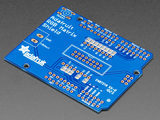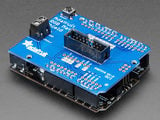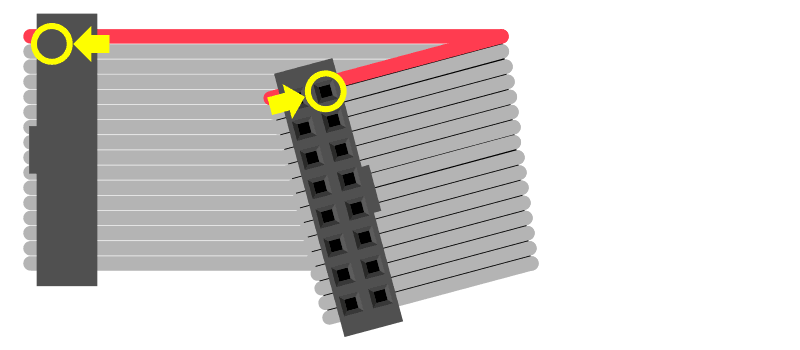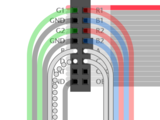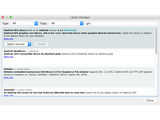
Overview
This guide is for boards in the ARDUINO ecosystem. We have a different guide for Raspberry Pi. Arduino Uno is limited to 32x16 pixels, single-buffered.
Bring a little bit of Times Square into your home with our RGB LED matrix panels. These panels are normally used to make video walls — here in New York we see them on the sides of buses and on bus stops — to display animations or short video clips. We thought they looked really cool so we picked up a few boxes from the factory. One has 512 bright RGB LEDs arranged in a 16x32 grid on the front, the other has 1024 LEDs in a 32x32 grid. On the back is a PCB with IDC connectors (one set for input, one for output: in theory you can chain these together) and 12 16-bit latches that allow you to drive the display with a 1:8 (16x32) or 1:16 (32x32) scan rate.
COMPATIBLE HARDWARE
The following boards are plug-and-play ready with the RGB Matrix Shield and software mentioned in this guide:
- Adafruit Metro M0
- Arduino Zero
- Arduino Uno (or compatible ATmega328P boards) — limited to 32x16 matrix, no double-buffering (needed for flicker-free animation)
The following are supported by the software, but require additional wiring or jumpers to use the RGB Matrix Shield:
- Arduino Mega (or compatible ATmega2560 boards)
- Adafruit Metro M4
The following are NOT supported by the software or shield:
- Arduino Leonardo (or compatible ATmega32U4 boards)
- Netduino and other Arduino-alikes not mentioned in above lists (but other libraries or shields might exist elsewhere)
- Teensy (but see the SmartLED Shields and software for Teensy 3.X and 4.X, which provide excellent performance)
- Raspberry Pi (but there are different Bonnets and HATs for this)
These panels require 12 or 13 digital pins (6 bit data, 6 or 7 bit control) and a good 5V power supply, at least a couple amps per panel. We suggest our 2A (or larger) regulated 5V adapters and either a terminal block DC jack, or solder a jack from our DC extension cord. Please read the rest of our tutorial for more details!
Keep in mind that these displays are normally designed to be driven by FPGAs or other high speed processors; they do not have built in PWM control of any kind. Instead, you're supposed to redraw the screen over and over to 'manually' PWM the whole thing. On a 16 MHz Arduino, we managed to squeeze 12-bit color (4096 colors) but this display would really shine if driven by an FPGA, CPLD, Propeller, XMOS or other high speed multi-processor controller.
Of course, we wouldn't leave you with a datasheet and a "good luck!" We have a full wiring diagrams and working Arduino library code with examples from drawing pixels, lines, rectangles, circles and text. You'll get your color blasting within the hour! On most Arduino-compatible boards, you'll need 12 digital pins, and about 800 bytes of RAM to hold the 12-bit color image (double that for the 32x32 matrix, double again for smooth double-buffered animation).
Power
Although LEDs are very efficient light sources, get enough of them in one place and the current really adds up.
A single 32x16 or 32x32 RGB matrix, running full tilt (all pixels set white), can require nearly 4 Amps of current! Double that figure for a 64x32 matrix.
On average though, displaying typical graphics and animation, these panels will use less…a 2A supply is usually sufficient for a single 32x16 or 32x32 panel, or 4A for a 64x32 panel. There’s no harm in using a larger power supply rated for more Amps (e.g. a 10A supply), but never use one with a higher Voltage (use 5V, period)!
On these panels, the power connection is separate from the data connection. Let’s begin by connecting a 5V supply…
Our parts suppliers occasionally make revisions to designs. As a result, the connections have changed over time. We'll walk through the different wiring combinations here…pick the explanation that matches the panel(s) you received.
Two different types of power connectors have made an appearance:
On the left is a screw post power connector (with adjacent pads for soldering wires directly). On the right, a Molex-style header. Some panels will have two headers…the power cable included with these panels has connectors for both headers.
With the posts-and-pads connector, you can either screw down the spades from the power cable, or another approach is to cut a 2.1mm jack from this extension cord and solder it to the pads on the panel back. This way you can plug the 5V from a wall adapter right in (the one we have in the shop is suggested). Simply cut the other half of the cable off, and strip the wiring so you can solder the red wire to +5 and the black wire to ground.
If your power cable came with spades at the opposite end of this power cable, they can be screwed into a 2.1mm terminal block adapter. Works nicely! Don't allow the exposed connectors to contact metal though…you should probably cover this with heat-shrink tube or electrical tape.
Connections
These panels are normally designed for chaining (linking end-to-end into larger displays)…the output of one panel connects to the input of the next, down the line.
With the limited RAM in an Arduino, chaining is seldom practical. Still, it’s necessary to distinguish the input and output connections on the panel…it won’t respond if we’re connected to the wrong socket.
Flip the matrix over so you’re looking at the back, holding it with the two sockets situated at the left and right edges (not top and bottom).
On some panels, if you’re lucky, the sockets are labeled INPUT and OUTPUT (sometimes IN and OUT or similar), so it’s obvious which is the input socket.
If INPUT is not labeled, look for one or more arrows pointing in the horizontal direction (ignore any vertical arrows, whether up or down). The horizontal arrows show the direction data moves from INPUT to OUTPUT — then you know which connector is which.
If no such labels are present, a last option is to examine the plastic shroud around the connector pins. The key (notch) on the INPUT connector will face the outer edge of the panel (not the center).
The arrangement of pins on the INPUT connector varies with matrix size and the batch in which it was produced…
A 32x16 panel uses this pin arrangement. The labels might be slightly different, or the pins might not be labeled at all…but in either case, use this image for reference.
Notice there are four ground connections. To ensure reliable performance, all four should be connected to GND on the Arduino! A solderless breadboard is handy for making this split. | |
Here’s the layout for 32x32 and 64x32 panels. We’ll call this “Variant A.” Some panels use different labels, but the functions are identical.
The layout is very similar to the 32x16 panel, with pin “D” replacing one ground connection.
This is the layout we’ll be referencing most often.
If you have a 32x32 panel with no pin labels at all, then use this layout. | |
“Variant B” for 32x32 and 64x32 panels. The wiring is identical to Variant A above, only the labels are different.
Ground pins aren’t labeled, but still need to be connected.
LAT (latch) is labeled STB (strobe) here. R1/G1/B1/R2/G2/B2 are changed to R0/G0/B0/R1/G1/B1…but again, no functional difference, it’s just ink. | |
Our earliest 32x32 panels had a two-socket design, let’s call it “Variant C.” All the same pin functions are present but the layout is very different.
R/G/B on the upper socket correspond to R1/G1/B1 in Variant A. R/G/B on the lower socket correspond to R2/G2/B2.
All the other signals (A/B/C/D/CLK/LAT/OE) need to be connected to both sockets — e.g. one pin on the Arduino drives both CLK pins, and so forth. |
Connecting to Arduino
There are two or three methods for connecting a matrix to an Arduino:
- Jumper wires inserted between Arduino headers and a ribbon cable — this works well for testing and prototyping, but is not durable.
- The Adafruit RGB Matrix Shield makes connecting these panels to an Arduino as easy as can be, and is best for permanent installations.
- One could build a proto shield to replicate the pinout of option #2. But given the Matrix Shield’s low cost, this might not be worth the effort nowadays.
These panels are normally run by very fast processors or FPGAs, not a 16 MHz Arduino. To achieve reasonable performance in this limited environment, our software is optimized by tying specific signals to specific Arduino pins. A few control lines can be reconfigured, but others are very specific…you can’t wire the whole thing willy-nilly. The next pages demonstrate compatible wiring…one using the RGB Matrix Shield, the using jumper wires.
Connecting Using RGB Matrix Shield
This is the preferred method for pairing these matrices with an Arduino-sized board, as it’s quick and trouble-free.
The Adafruit RGB Matrix Shield works with the Arduino Uno and Zero, and the Adafruit Metro M0…and with one or more jumper wires can work with the Metro M4 (and potentially other boards with this form factor, if a compatible Arduino library is available).
The shield does not directly work with the Arduino Mega — additional jumper wires are needed to pins off the shield — see the “Jumper Wires” page for pinouts, or consider making your own Mega proto shield for that board.
The shield arrives unpopulated and you’ll need to do a little soldering to get it going. Header pins are installed from the underside and soldered on top. Three components — a button, power terminal and 16-pin header — insert from the top and are soldered underneath. |
The 16-pin (8x2) header must be installed in the correct orientation! The polarity notch is indicated on the silkscreen, or you can see in the photos above that the notch faces the digital I/O pins. If you install this backwards the matrix will not work!
Power to the LED matrix can be connected to the shield’s screw terminals — red wire to +5Vout, black wire to GND — and the whole circuit is then powered from the Arduino’s DC jack or a USB cable at a safe and regulated 5 Volts.
The shield requires a small modification to work with the Adafruit Metro M4:
|
A corresponding change is required in one’s code — look for the “CLK” pin definition in any of the matrix examples…
#define CLK 8And change the “8” to “A4”:
#define CLK A4Connecting with Jumper Wires
Ribbon cables and their corresponding headers are sometimes a topological puzzle. Here’s a trick to help keep track…
If you hold the ribbon cable flat — no folds — and with both connectors facing you, keys pointed the same direction — now there is a 1:1 correlation between the pins. The top-right pin on one plug links to the top-right on the other plug, and so forth. This holds true even if the cable has a doubled-over strain relief. As long as the keys point the same way and the plugs face the same way, pins are in the same positions at both ends.

Plugged into a socket on the LED matrix, one header now faces away from you. If you double the cable back on itself (not a twist, but a fold)…to access a specific pin on the socket, the left and right columns are now mirrored (rows are in the same order — the red stripe provides a point of reference). You’re looking “up” into the plug rather than “down” into the socket.
For example, R1 (the top-left pin on the INPUT socket) appears at the top-right of the exposed plug. You can jam a wire jumper in that hole to a corresponding pin on the Arduino…
So! From the prior page, refer to the socket that’s correct for your matrix type. The labels may be a little different (or none at all), but most are pretty close to what’s shown here.
Then swap the columns to find the correct position for a given signal. |
Either end of the ribbon cable can be plugged into the matrix INPUT socket. Notice below, the “key” faces the same way regardless.
With the free end of the ribbon toward the center of the matrix, the Arduino can be hidden behind it.
With the free end of the ribbon off the side, it’s easier to see both the front of the matrix and the Arduino simultaneously, for making additional connections or for troubleshooting.

Using color-coded wires helps a lot! If you don’t have colored wires, that’s okay, just pay close attention where everything goes. Our goal is a fully-populated plug like this:

32x32 and 64x32 matrices require three ground connections. 32x16 matrices have four.
Current Arduino Uno form-factor boards have three ground pins (the third is next to pin 13). If you need additional ground connections — for a 32x16 matrix, or if using an older Arduino board with only 2 ground pins — a solderless breadboard is handy for linking all these pins.
Arduino Mega boards have five ground pins. Same three as the Arduino Uno, plus two more next to pins 52 & 53. |
Pins R1, G1 and B1 (labeled R0, B0 and G0 on some matrices) deliver data to the top half of the display.
On the Arduino Uno and Adafruit Metro (328, M0 or M4) boards, connect these to digital pins 2, 3 and 4.
On Arduino Mega, connect to pins 24, 25 and 26. |
Pins R2, G2 and B2 (labeled R1, G1 and B1 on some matrices) deliver data to the bottom half of the display. These connect to the next three Arduino pins…
On Arduino Uno and Adafruit Metros, that’s pins 5, 6 and 7.
On Arduino Mega, pins 27, 28 and 29. |
Pins A, B, C and D select which two rows of the display are currently lit. (32x16 matrices don’t have a “D” pin — it’s connected to ground instead.)
These connect to pins A0, A1, A2 and (if D pin present) A3. This is the same for all boards. |
The LAT signal connects to Arduino pin 10. This is the same for all boards. The LAT (latch) signal marks the end of a row of data. |
OE connects to Arduino pin 9. This is the same for all boards. OE (output enable) switches the LEDs off when transitioning from one row to the next. |
CLK connects to…
The CLK (clock) signal marks the arrival of each bit of data. |
That’s it. You can skip ahead to the “Test Example Code” page now.
Connecting Using a Proto Shield
As mentioned on the “Jumper” page: if you hold a ribbon cable flat — no folds — and with both connectors facing you, keys pointed the same direction — there’s is a 1:1 correlation between the pins. The top-right pin on one plug links to the top-right on the other plug, and so forth. This holds true even if the cable has a doubled-over strain relief. As long as the keys point the same way and the plugs face the same way, pins are in the same positions at both ends.

Either end of the ribbon cable can be plugged into the matrix INPUT socket.
The free end of the ribbon can point toward the center of the matrix, or hang off the side…the pinout is still the same. Notice below the direction of the “key” doesn’t change.

A dual-row header gets installed on the proto shield, similar to the connector on the matrix. Just like the ribbon cable lying flat, as long as these two headers are aligned the same way, they’ll match pin-for-pin; unlike the jumper wire method from the prior page, mirroring doesn’t happen.
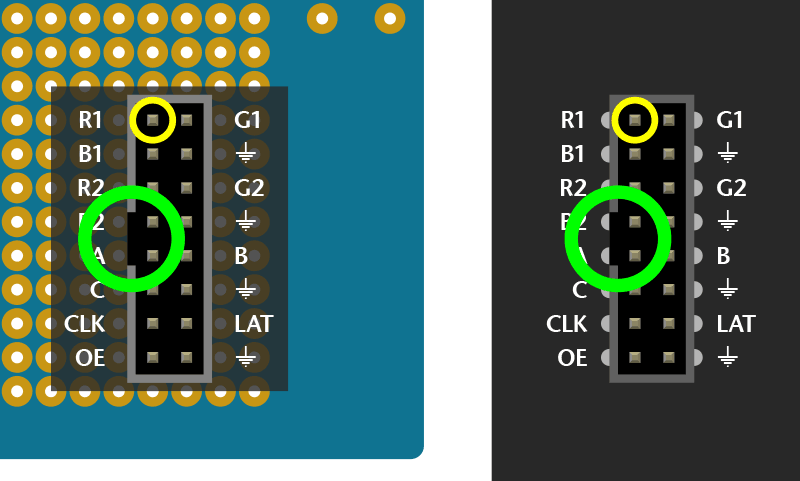
Wires are then soldered from the header to specific Arduino pins on the proto shield. Try to keep wire lengths reasonably short to avoid signal interference.
Using color-coded wires helps a lot! If you don’t have colored wires, that’s okay, just pay close attention where everything goes. Our goal is a proto shield something like this:

It’s not necessary to install all the buttons and lights on the proto shield if you don’t want — just the basic header pins are sufficient.
For Arduino form-factor boards, using an Adafruit proto shield: if using a shrouded socket (like on the back of the matrix — with the notch so a ribbon cable only fits one way) you’ll need to place this near the “Reset” end of the shield. The plastic shroud obscures a lot of pins. Others’ proto shields may be laid out different…look around for a good location before committing to solder.
For Arduino Mega with our corresponding proto shield: a shrouded socket fits best near the middle of the shield.
Otherwise, you can use a plain 2x8-pin male header, or two 1x8 sections installed side-by-side (as in the photo above). Since there’s no alignment key with this setup, you might want to indicate it with some tape or a permanent marker.
Depending on the make and model of proto shield, some pins are designed to connect in short rows. Others don’t. For the latter, strip a little extra insulation and bend the wire to wrap around the leg of the socket from behind, then solder. |
32x32 and 64x32 matrices require three ground connections. 32x16 matrices have four.
Most proto shields have tons of grounding points, so you shouldn’t have trouble finding places to connect these. |
Pins R1, G1 and B1 (labeled R0, B0 and G0 on some matrices) deliver data to the top half of the display. On the Arduino Uno and Adafruit Metro (328, M0 or M4) boards, connect these to digital pins 2, 3 and 4. On Arduino Mega, connect to pins 24, 25 and 26. |
Pins R2, G2 and B2 (labeled R1, G1 and B1 on some matrices) deliver data to the bottom half of the display. These connect to the next three Arduino pins… On Arduino Uno and Adafruit Metros, that’s pins 5, 6 and 7. On Arduino Mega, pins 27, 28 and 29. |
Pins A, B, C and D select which two rows of the display are currently lit. (32x16 matrices don’t have a “D” pin — it’s connected to ground instead.)
These connect to pins A0, A1, A2 and (if D pin present) A3. This is the same for both the Arduino Uno and Mega. |
For 32x32 and 64x32 matrices, LAT connects to Arduino pin 10. This is the same for all boards. The LAT (latch) signal marks the end of a row of data. |
OE connects to Arduino pin 9. This is the same for all boards. OE (output enable) switches the LEDs off when transitioning from one row to the next. |
CLK connects to…
The CLK (clock) signal marks the arrival of each bit of data. |
Here’s that photo again of a completed shield. You can tell this is for a 32x16 matrix, because there are four ground connections (one of the long vertical strips is a ground bus — see the tiny jumpers there?).
The ribbon cable to the matrix would plug into this with the key facing left.
The colors and positions don’t quite match the examples above, but are close. G1 and G2 are yellow wires. LAT is the purple wire and should go to pin 10 now (we changed around some things in the Arduino library).

Test Example Code
We have example code ready to go for these displays. It does not work with every board out there. See the “Compatible Hardware” lists on the opening page for guidance.
Arduino Uno support is limited to the 32x16 matrix, and only “single-buffered” (i.e. no smooth animation), despite any comments in the examples that might suggest otherwise.
Over time, RAM required by the core Arduino code and the matrix-driving graphics libraries has increased…a few bytes here and there as bugs are fixed and features are added. Early on, 32x32 (or double-buffered 32x16) just barely fit in the Arduino Uno’s RAM, with a few dozen bytes to spare for user code. This is no longer the case. But you might still see references to this in older code.
Some libraries need to be downloaded and installed: first is the RGB Matrix Panel library (this contains the low-level code specific to this device), then the Adafruit GFX Library (which handles graphics operations common to many displays we carry) and Adafruit BusIO.
Both libraries can be found and installed using the Arduino Library Manager (Sketch→Include Library→Manage Libraries…). Search for “gfx” and “rgb matrix panel” and install the corresponding Adafruit libraries. |
Now you are ready to test! Open up the IDE and load File→Examples→RGBmatrixPanel→testcolors_16x32 (for the 16x32 panel) or File→Examples→RGBmatrixPanel→colorwheel_32x32 (for the 32x32 panel). There’s also a testshapes_32x64 example for boards with sufficient RAM.
If using an Arduino Mega 2560, in addition to wiring changes previously mentioned, you'll need to make a small change to each of the example sketches. This line:
#define CLK 8 // MUST be on PORTB! (Use pin 11 on Mega)#define CLK 11(Any of digital pins 10-13 and 50-53 can be used for this function on the Mega, with the corresponding wiring change. The examples all reference pin 11.)
If using an Adafruit Metro M4 (not M0 or 328), the CLK change would instead be:
#define CLK A4
or, with the 32x32 panel:

The most useful line to look at is:
matrix.drawPixel(x, y, matrix.Color333(r, g, b));Library

// draw a pixel in solid white
matrix.drawPixel(0, 0, matrix.Color333(7, 7, 7)); // fix the screen with green
matrix.fillRect(0, 0, 32, 16, matrix.Color333(0, 7, 0)); // draw a box in yellow
matrix.drawRect(0, 0, 32, 16, matrix.Color333(7, 7, 0)); // draw an 'X' in red
matrix.drawLine(0, 0, 31, 15, matrix.Color333(7, 0, 0));
matrix.drawLine(31, 0, 0, 15, matrix.Color333(7, 0, 0)); // draw a blue circle
matrix.drawCircle(7, 7, 7, matrix.Color333(0, 0, 7));
// fill a violet circle
matrix.fillCircle(23, 7, 7, matrix.Color333(7, 0, 7));fillScreen allows you to fill the entire screen with a single color:
// fill the screen with 'black'
matrix.fillScreen(matrix.Color333(0, 0, 0)); // draw some text!
matrix.setCursor(1, 0); // start at top left, with one pixel of spacing
matrix.setTextSize(1); // size 1 == 8 pixels high
// print each letter with a rainbow color
matrix.setTextColor(matrix.Color333(7,0,0));
matrix.print('1');
matrix.setTextColor(matrix.Color333(7,4,0));
matrix.print('6');
matrix.setTextColor(matrix.Color333(7,7,0));
matrix.print('x');
matrix.setTextColor(matrix.Color333(4,7,0));
matrix.print('3');
matrix.setTextColor(matrix.Color333(0,7,0));
matrix.print('2');
matrix.setCursor(1, 9); // next line
matrix.setTextColor(matrix.Color333(0,7,7));
matrix.print('*');
matrix.setTextColor(matrix.Color333(0,4,7));
matrix.print('R');
matrix.setTextColor(matrix.Color333(0,0,7));
matrix.print('G');
matrix.setTextColor(matrix.Color333(4,0,7));
matrix.print("B");
matrix.setTextColor(matrix.Color333(7,0,4));
matrix.print("*");














